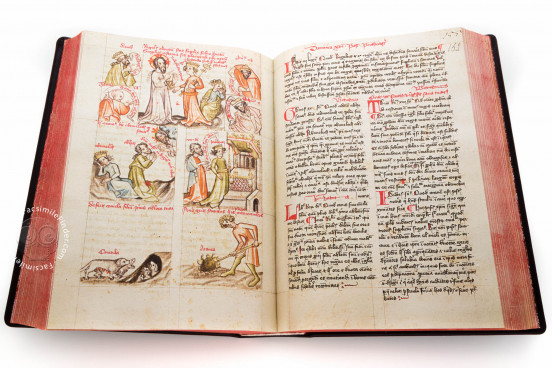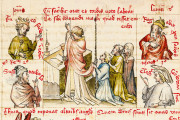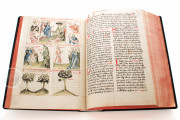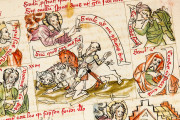The work contained in the Budapest Concordance of Charity is that of a fourteenth-century author, Ulrich von Lilienfeld, who between 1345-1351 was the abbot of the Cistercian monastery in Lilienfeld, Lower Austria. Concordantiae caritatis is a typological manuscript. The main characteristic of a typological work is that events described in the Old and in the New Testament are placed within a structure according to their role in the story of Redemption. The scenes in the Old Testament serve as a prototype for those in the New Testament, which are the final fulfillment, and form a unified, mutually enlightening whole.
Concordantiae caritatis is the most complete typological collection of the Middle Ages. It comprises 238 typological units with an encyclopedic intention. Not only is it extraordinary because of its extent; it is also unique from the aspect of its content. Natural phenomena and scenes taken from the lives of saints, which, like that of Christ, serve as moral examples, became integral parts of its typological system. The typological units of Concordantiae caritatis each take up two facing pages. On the right we can read the text, while the illustrations are placed on the left. Every typological unit is made up of five parts. The main scene is found at the centre on the top of the page with two prototypes from the Old Testament below it, and two natural parallels at the bottom of the page. The work concludes with a “picturecatechism” the text of which is partly in German. Here the virtues and vices play the main role: they fight each other riding on the back of various animals; they assist the knight of Christ (Miles Christi) into the saddle, elsewhere they drive chariots to heaven or to hell.
Both because of its author and the spread of its copies, Concordantiae caritatis is a characteristically Central European work. All the copies that came down to us are manuscripts and most of them originate from Southern Germany and Austria. A good part of them are still preserved in German and Austrian libraries. These copies testify that although the author of Concordantiae caritatis destined it to be an illustrated volume equally suitable for educational and preaching purposes, his contemporaries would rather use it in preparation for sermons. Only eight copies of Concordantiae caritatis known today contain illustrations and of these few the Budapest manuscript is worthy of a high position due to the high quality and completeness of its cycle of illustrations.
In line with the wealth of contents of the Concordantiae caritatis we read descriptions of no less than 1225 scenes and natural phenomena over 524 pages in the Budapest manuscript. As many coloured pen-and-ink drawings help in understanding the text. They represent biblical events, legends, mythical and real animals coming to life in an environment that immortalizes many details of the age’s material culture. The technical peculiarities of the coloured pen-andink drawings give the illustrations an exceptionally immediate effect; to this day the moment of their creation is preserved for us. At the same time the Budapest Concordantiae caritatis is worthy of notice not solely as an inexhaustible depository of representing the world surrounding us and created by the supernatural power and by mankind: the manuscript is at least as interesting in its own historicity. As the colophon betrays, the text was written in 1413 by the Viennese burgher Stephanus Lang, in his own home. Stephanus Lang was an educated person who, after receiving the degree of baccalaureus in artibus at Prague University, started a family in Vienna and occupied a number of municipal positions: as notary, as the Kirchmeister of Stephansdom, and more than once as a city alderman. His deep faith is borne out by his Memento mori, like meditative text on death, circulated under the title Memoria improvisae mortis and his will, composed in 1419, the latter of which provides a picture of his family and of his wealth.
Seven artists, visibly in contact with each other but of varying education, participated in the illustration of the Budapest Concordantiae caritatis. Of them the most talented one can be linked with the circle of the Master of the Sankt Lambrecht Votive Picture, a group whose style became dominant in Viennese panel painting in the first third of the fifteenth century. We know of no other works by the creators of the illustration cycle, or at least none that we can attribute to any one of them without any shadow of doubt. At the same time this means that without the Budapest Concordantiae caritatis Viennese art of the years around 1400 (important on its own right in the European context) would be poorer by more than 1,000 pictures and a good handful of artists. The difference in styles of the masters of the manuscript throw an interesting light on the cultural variety of old Vienna, while their interrelationships provide us with a glimpse of late medieval workshop-practice, the possible forms of cooperation among artists and in the final analysis the nature of art imagery.
The Budapest Concordantiae caritatis has formed a part of Hungarian book and library history since the seventeenth century. In 1646 it belonged to Pál Lászlóffy (who may have acquired it in Vienna), in 1666 it was held in Bajmóc Castle (today Bojnice, Slovakia) of the Pálffy family, and in 1795 it enriched the library of the Piarist Order in Pozsony szentgyörgy (today Svätý Jur, Slovakia). It was here that it was given a gilded leather binding. In 1906 the volume entered the possession of the Central Library of the Piarist Order in Budapest. The first publication about the work was by the Piarist monk László Papp, in 1979. Following this, the manuscript was quick to attract the attention of Hungarian and foreign researchers alike, although no thorough analysis could be undergone.
We have 1 facsimile edition of the manuscript "Budapest Concordance of Charity": Budapester Concordantiae Caritatis facsimile edition, published by Schöck ArtPrint Kft., 2011
Request Info / Price






